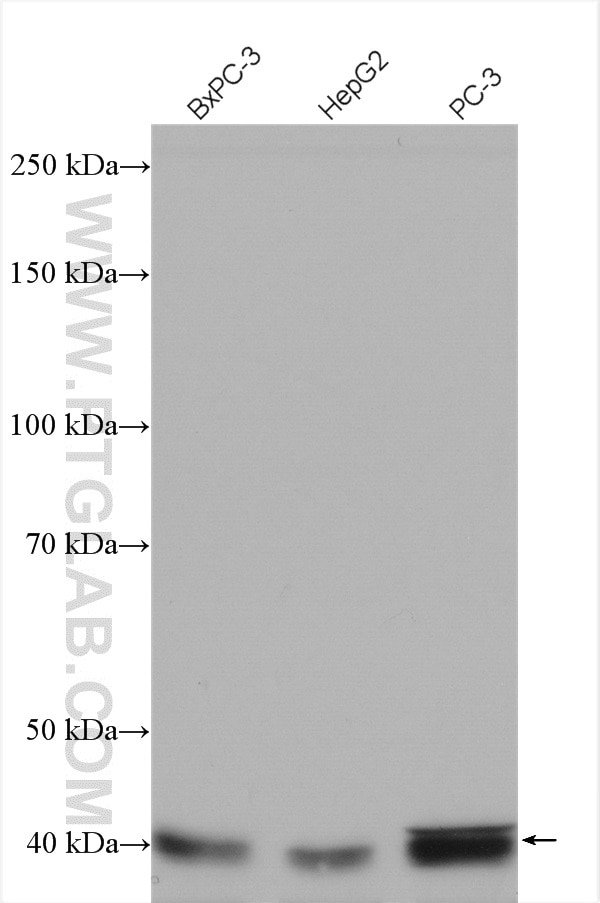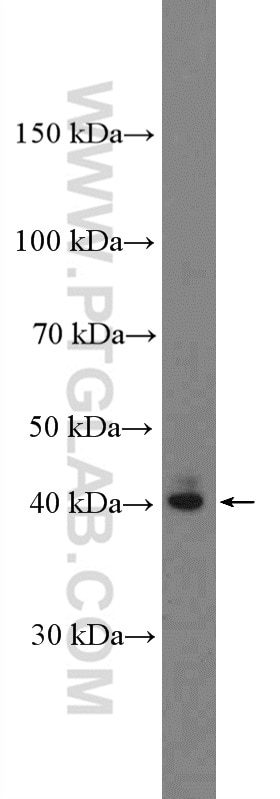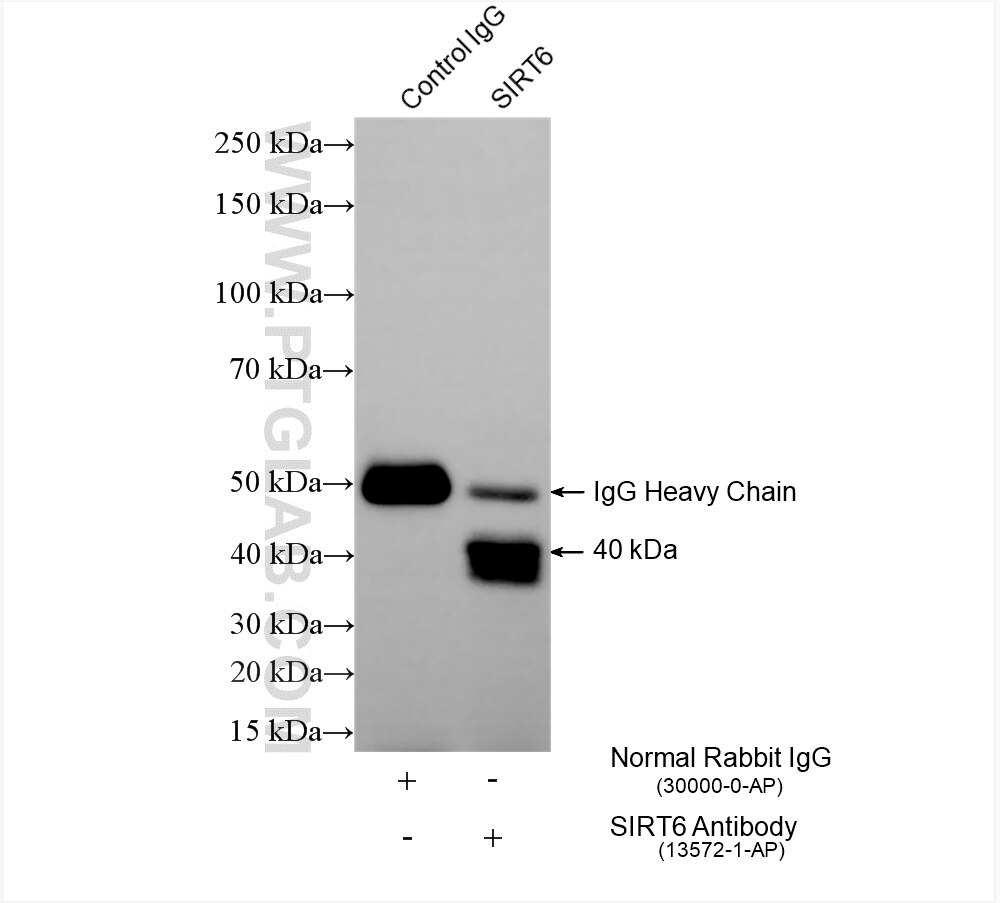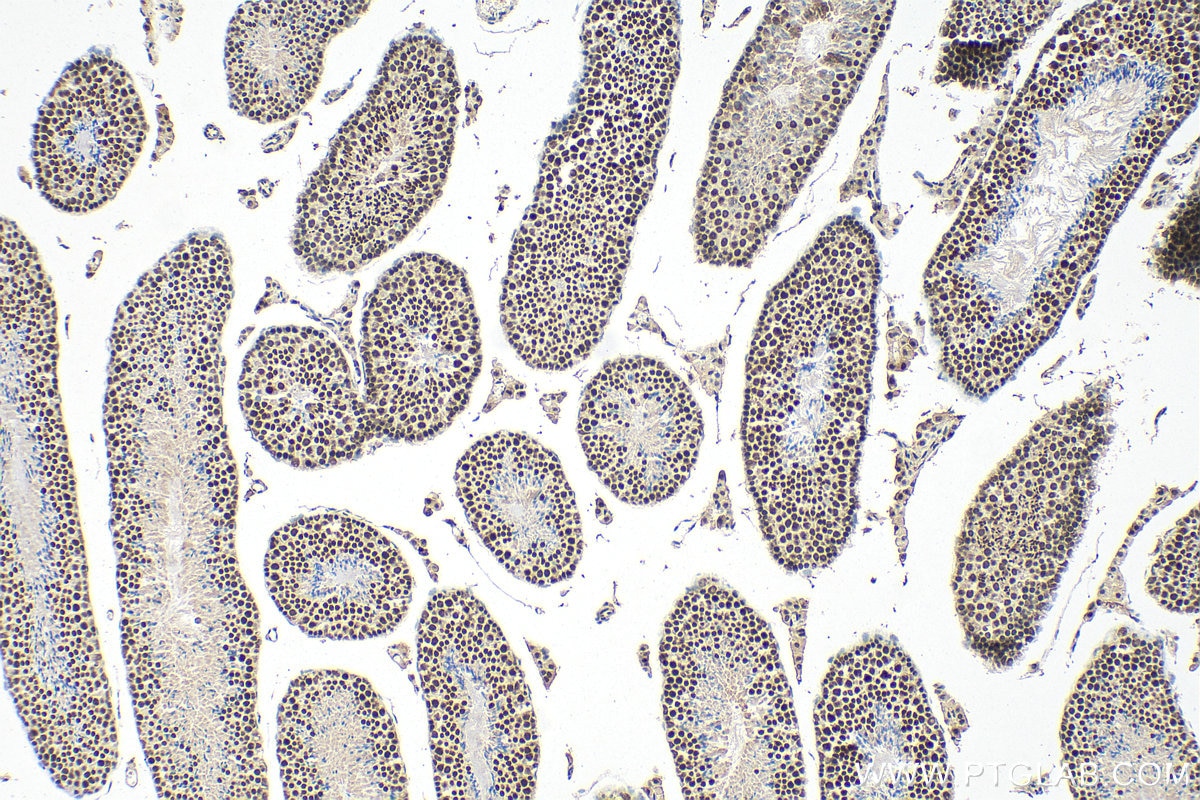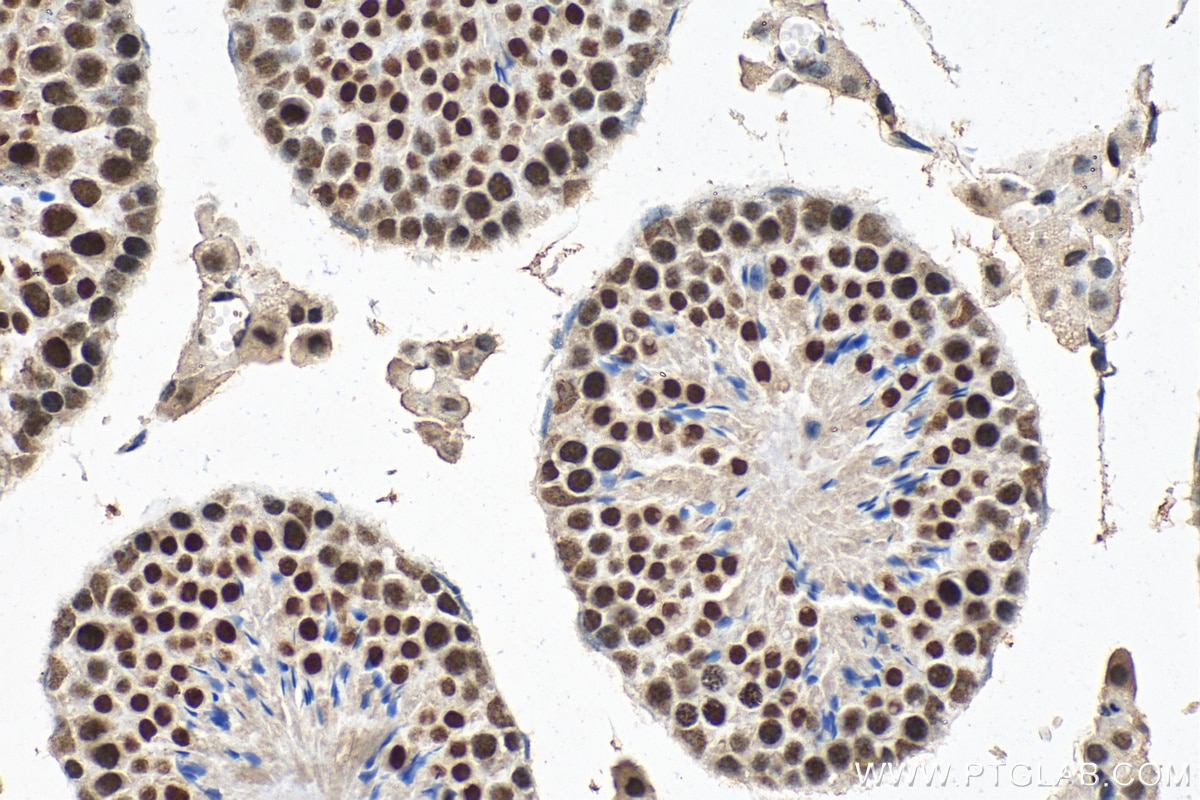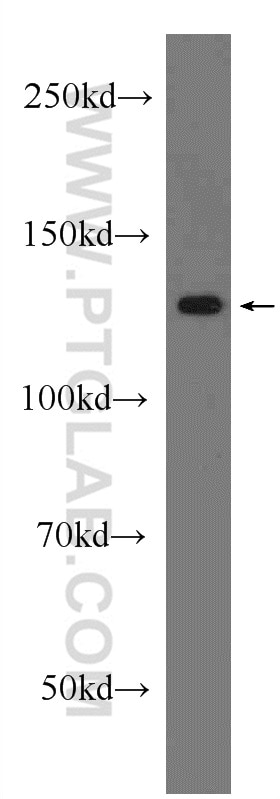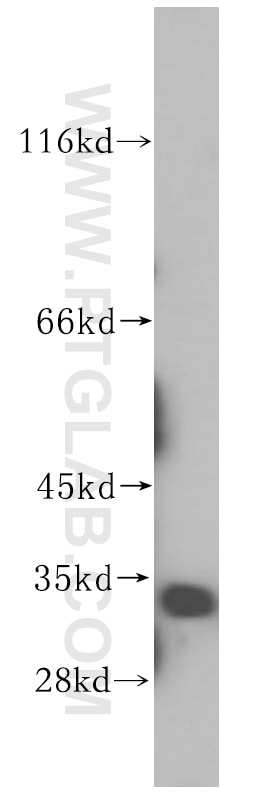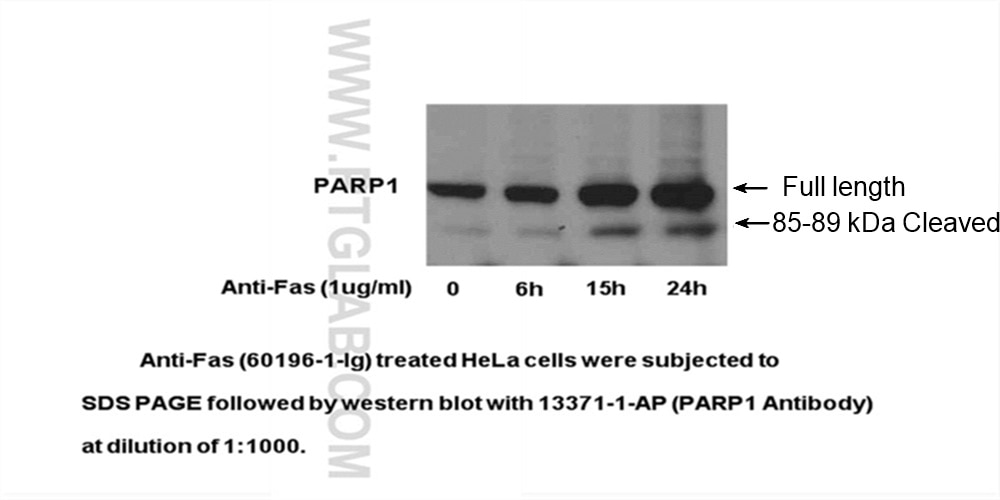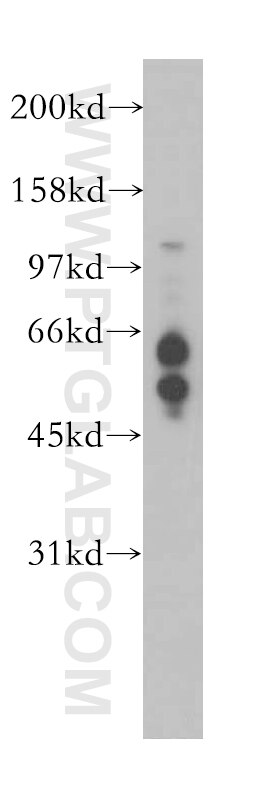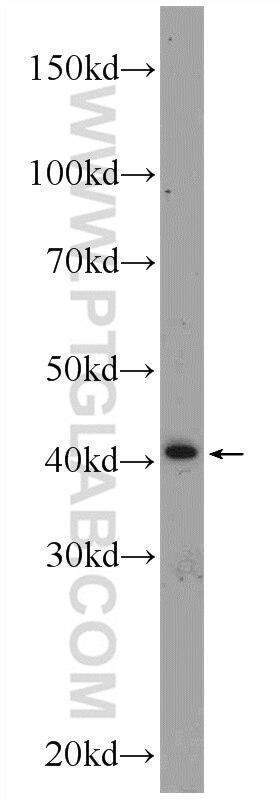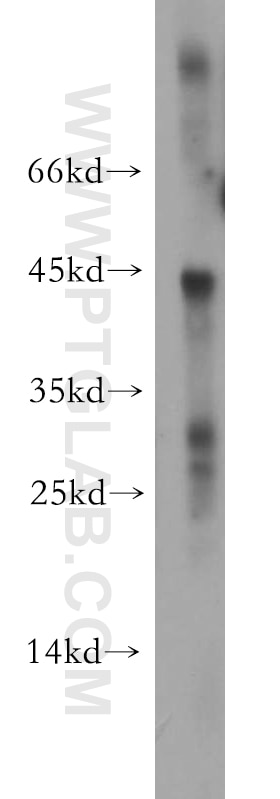- Featured Product
- KD/KO Validated
SIRT6 Polyklonaler Antikörper
SIRT6 Polyklonal Antikörper für WB, IP, IHC, ELISA
Wirt / Isotyp
Kaninchen / IgG
Getestete Reaktivität
human, Maus, Ratte und mehr (1)
Anwendung
WB, IP, IF, FC, IHC, CoIP, ELISA
Konjugation
Unkonjugiert
Kat-Nr. : 13572-1-AP
Synonyme
Galerie der Validierungsdaten
Geprüfte Anwendungen
| Erfolgreiche Detektion in WB | BxPC-3-Zellen, HepG2-Zellen, Mauslebergewebe, PC-3-Zellen |
| Erfolgreiche IP | BxPC-3-Zellen |
| Erfolgreiche Detektion in IHC | Maushodengewebe Hinweis: Antigendemaskierung mit TE-Puffer pH 9,0 empfohlen. (*) Wahlweise kann die Antigendemaskierung auch mit Citratpuffer pH 6,0 erfolgen. |
Empfohlene Verdünnung
| Anwendung | Verdünnung |
|---|---|
| Western Blot (WB) | WB : 1:500-1:3000 |
| Immunpräzipitation (IP) | IP : 0.5-4.0 ug for 1.0-3.0 mg of total protein lysate |
| Immunhistochemie (IHC) | IHC : 1:250-1:1000 |
| It is recommended that this reagent should be titrated in each testing system to obtain optimal results. | |
| Sample-dependent, check data in validation data gallery | |
Veröffentlichte Anwendungen
| KD/KO | See 6 publications below |
| WB | See 30 publications below |
| IHC | See 13 publications below |
| IF | See 11 publications below |
| IP | See 1 publications below |
| FC | See 1 publications below |
| CoIP | See 1 publications below |
Produktinformation
13572-1-AP bindet in WB, IP, IF, FC, IHC, CoIP, ELISA SIRT6 und zeigt Reaktivität mit human, Maus, Ratten
| Getestete Reaktivität | human, Maus, Ratte |
| In Publikationen genannte Reaktivität | human, Maus, Ratte, Rind |
| Wirt / Isotyp | Kaninchen / IgG |
| Klonalität | Polyklonal |
| Typ | Antikörper |
| Immunogen | SIRT6 fusion protein Ag4469 |
| Vollständiger Name | sirtuin (silent mating type information regulation 2 homolog) 6 (S. cerevisiae) |
| Berechnetes Molekulargewicht | 39 kDa |
| Beobachtetes Molekulargewicht | 39-45 kDa |
| GenBank-Zugangsnummer | BC028220 |
| Gene symbol | SIRT6 |
| Gene ID (NCBI) | 51548 |
| Konjugation | Unkonjugiert |
| Form | Liquid |
| Reinigungsmethode | Antigen-Affinitätsreinigung |
| Lagerungspuffer | PBS mit 0.02% Natriumazid und 50% Glycerin pH 7.3. |
| Lagerungsbedingungen | Bei -20°C lagern. Nach dem Versand ein Jahr lang stabil Aliquotieren ist bei -20oC Lagerung nicht notwendig. 20ul Größen enthalten 0,1% BSA. |
Hintergrundinformationen
SIRT6, also named as SIR2L6, belongs to the sirtuin family. It is known to deacetylate H3K9, H3K56 and CtIP in vivo. SIRT6 regulates the expression of a large number of stress-responsive and metabolism related genes, promotes genomic stability and stimulates base excision and double strand break DNA repair(PMID: 20729089). By maintaining both the integrity and the expression of the mammalian genome, SIRT6 thus serves several roles that parallel Sir2 function(PMID: 20729089). In addtion, Sirt6-deficient animals develop normally for several weeks after birth, but succumb to an acute multi-organ degenerative syndrome that is uniformly lethal by one month of age(PMID: 19135889). This antibody is a rabbit polyclonal antibody raised against full length human SIRT6 antigen.
Protokolle
| Produktspezifische Protokolle | |
|---|---|
| WB protocol for SIRT6 antibody 13572-1-AP | Protokoll herunterladen |
| IHC protocol for SIRT6 antibody 13572-1-AP | Protokoll herunterladen |
| IP protocol for SIRT6 antibody 13572-1-AP | Protokoll herunterladen |
| Standard-Protokolle | |
|---|---|
| Klicken Sie hier, um unsere Standardprotokolle anzuzeigen |
Publikationen
| Species | Application | Title |
|---|---|---|
Nat Commun Targeting USP47 overcomes tyrosine kinase inhibitor resistance and eradicates leukemia stem/progenitor cells in chronic myelogenous leukemia. | ||
Nat Commun Cordycepin prevents radiation ulcer by inhibiting cell senescence via NRF2 and AMPK in rodents. | ||
Redox Biol A new FGF1 variant protects against adriamycin-induced cardiotoxicity via modulating p53 activity. | ||
Oncogene Sirtuin-mediated deacetylation of hnRNP A1 suppresses glycolysis and growth in hepatocellular carcinoma. | ||
Stem Cells SIRT6 regulates osteogenic differentiation of rat bone marrow mesenchymal stem cells partially via suppressing the nuclear factor-kappa B signaling pathway.
| ||
Oxid Med Cell Longev Total Sesquiterpene Glycosides from Loquat Leaves Ameliorate HFD-Induced Insulin Resistance by Modulating IRS-1/GLUT4, TRPV1, and SIRT6/Nrf2 Signaling Pathways. |
